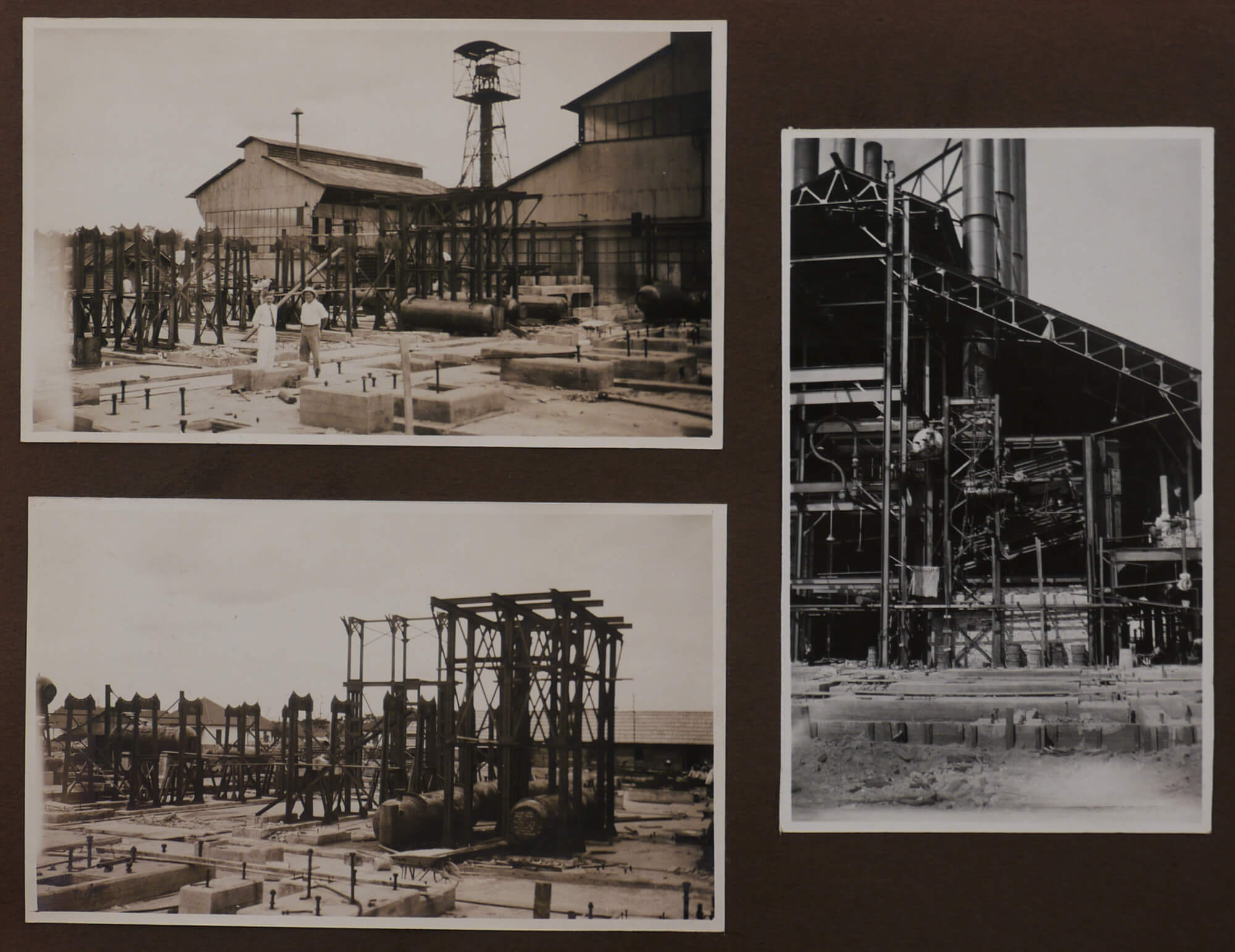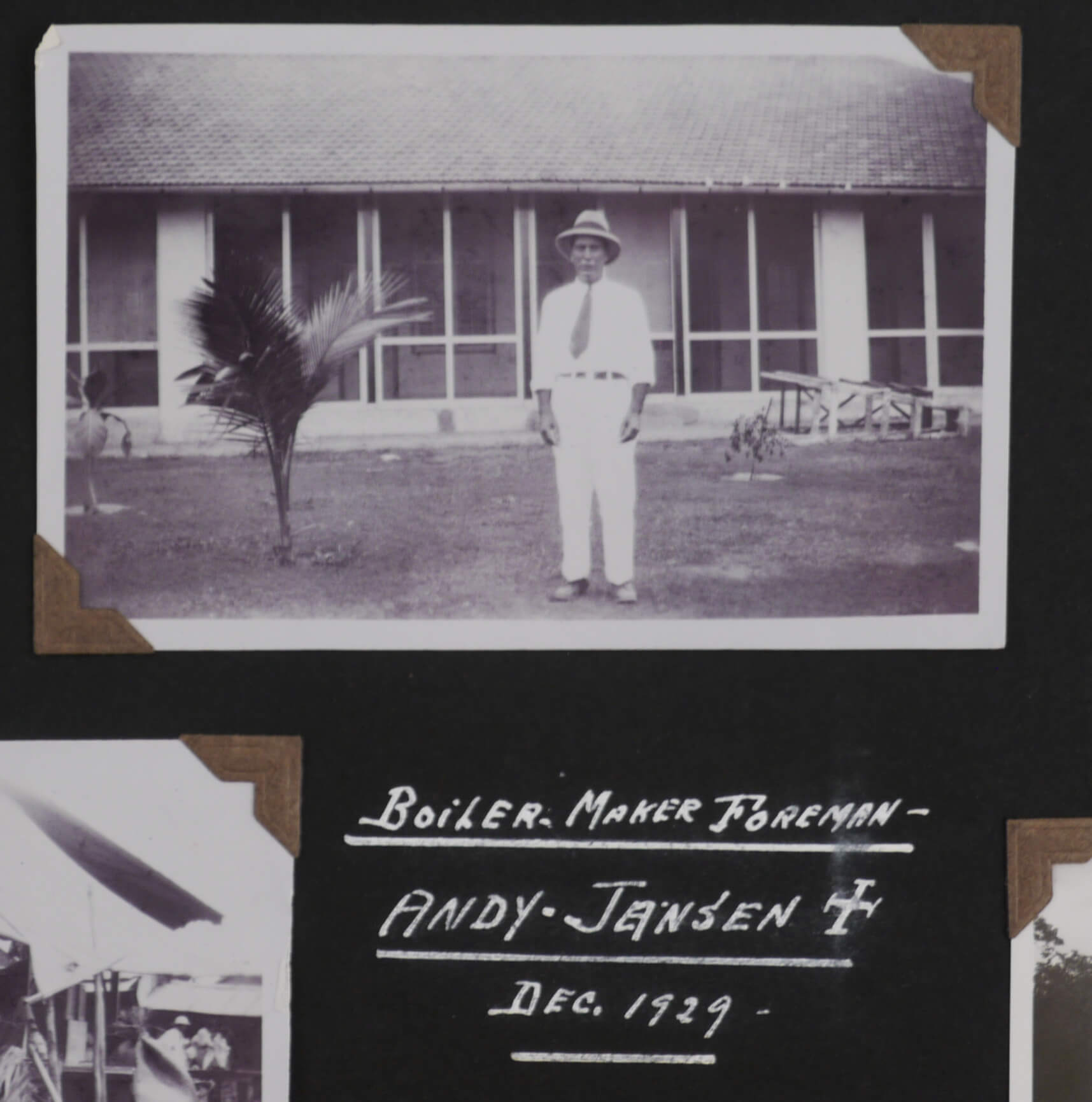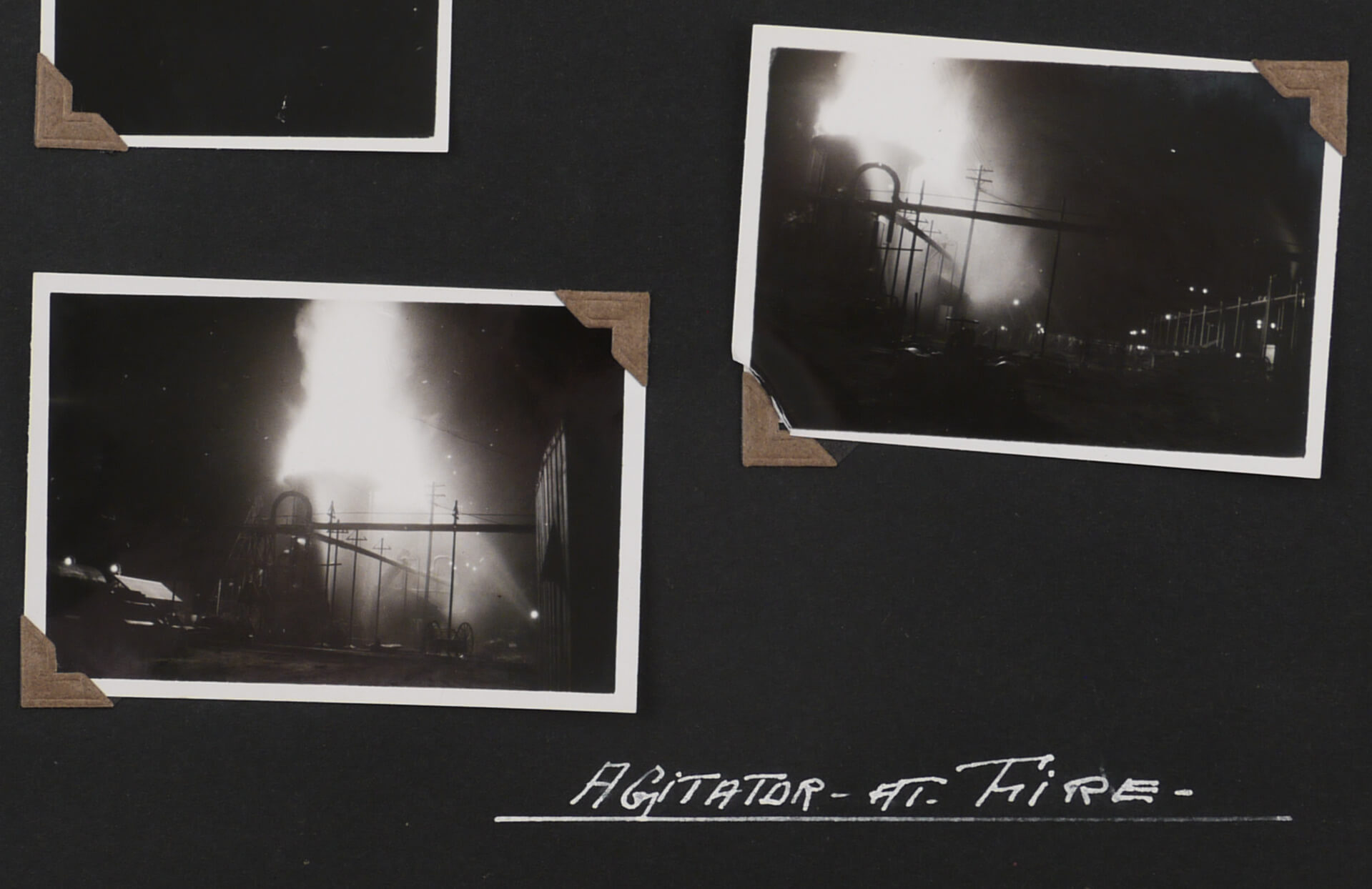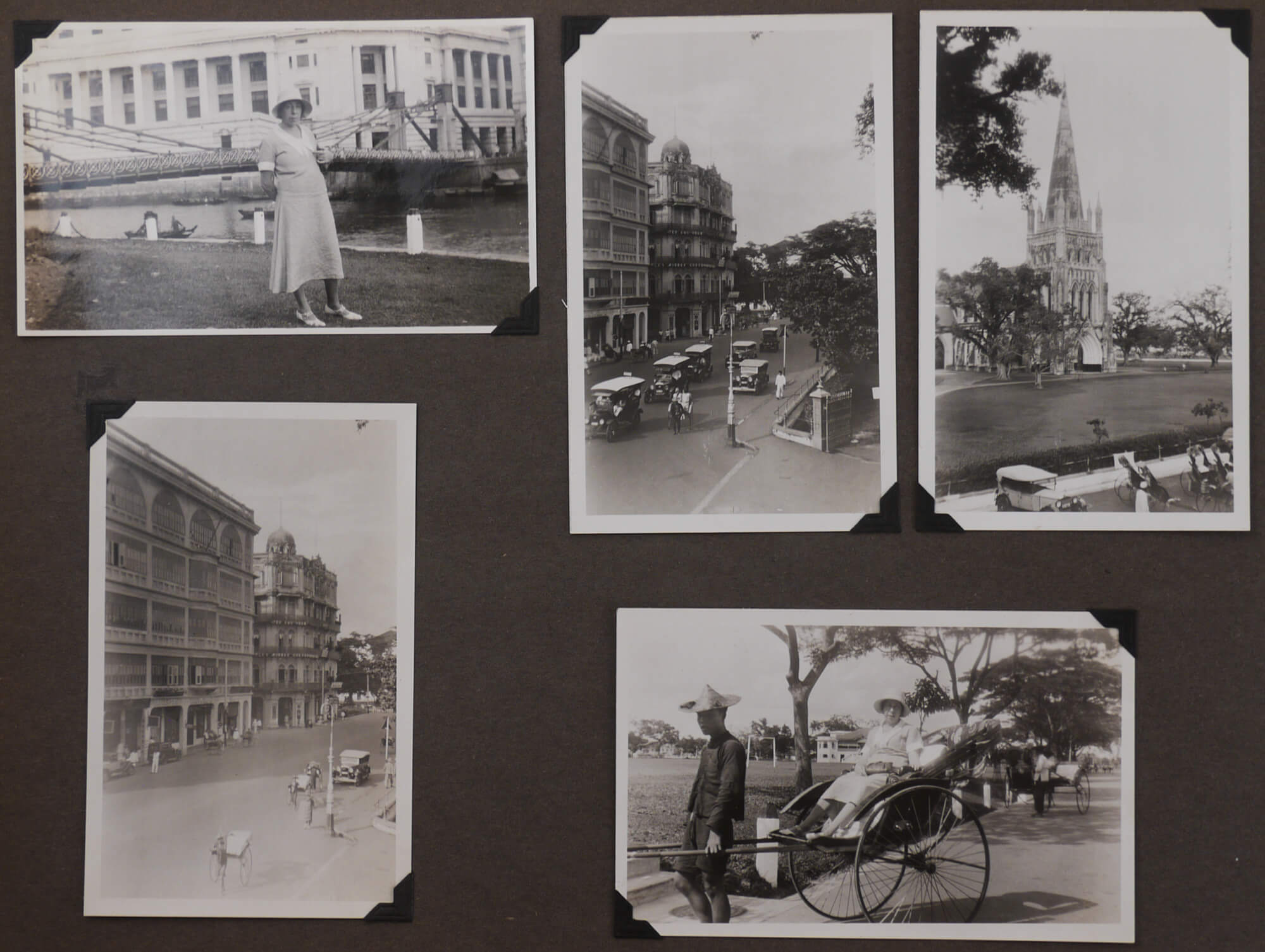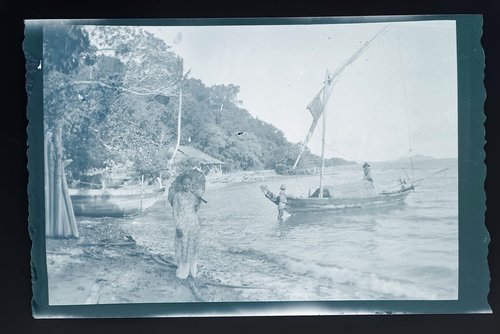







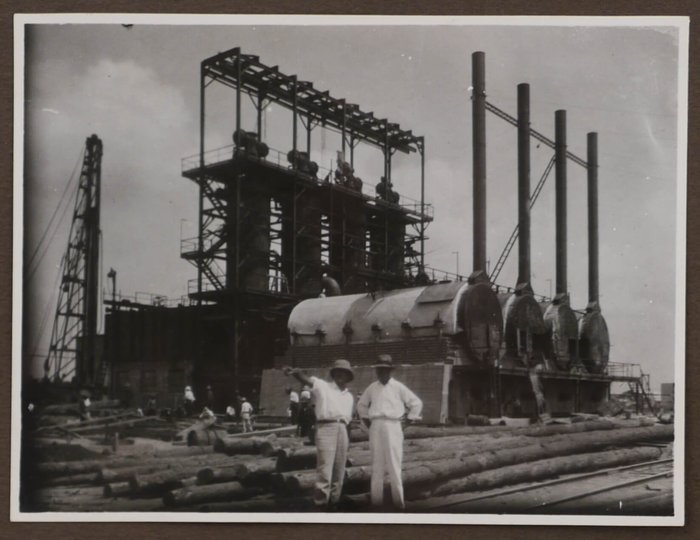



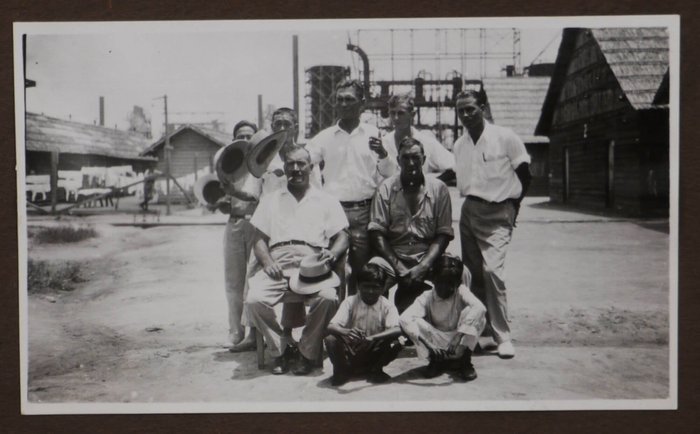
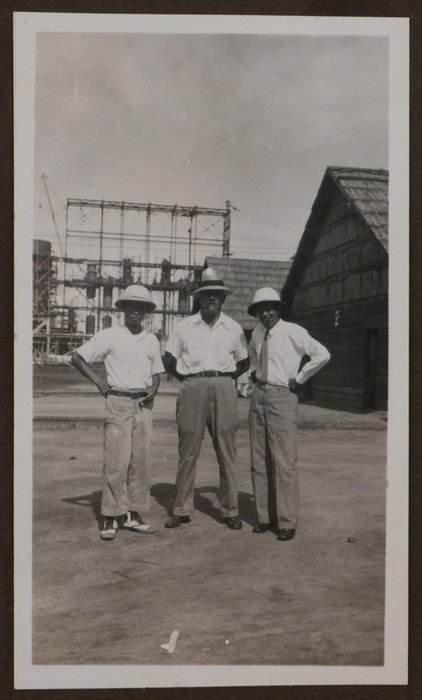







































#P44
Ca. 1929-1931
Three albums with ca. 416 original gelatin silver photos. Oblong Folio album (ca. 27,5x36,5 cm). 25 card stock leaves with tissue guards. With 206 mounted gelatin silver photographs from ca. 8,5x14 cm (3 ¼ x 5 ½ in) to ca. 6,5x10,5 cm (2 ½ x 4 ¼ in). Most photos with period white ink notes in English on the mounts (the captions relate either to individual photos or groups of photos). Period decorative cloth album fastened with a string; gilt-lettered title “Photographs” on the front board. One album leaf removed from the stub and loosely inserted, five or six photos were previously removed from the album, but overall a very good collection of interesting photos. Oblong Folio album (ca. 29,5x40 cm). 24 card stock leaves with tissue guards (9 blank). With 132 mounted gelatin silver photographs of various size, including one panoramic view ca. 9x30 cm (3 ½ x 11 ¾ in) and seven larger photos from ca. 17,5x24 cm (7 x 9 ½ in) to ca. 16x20 cm (8 ¼ x 7 ¾ in). The rest of the photos (some printed as postcards) are from ca. 8,5x14 cm (3 ¼ x 5 ½ in) to ca. 6x9 cm (2 ¼ x 3 ½ in). About fifty photos with period ink notes in English, German or Dutch on verso. About a dozen photos with ink stamps “Palmer Photo Service, S.S. President Coolidge” on verso. Period brown cloth album fastened with a string. Ten album leaves removed from the stub and loosely inserted, a few images very mildly faded, but overall a very good album of strong interesting photos.Oblong Quarto album (ca. 22,5x30 cm). 24 card stock leaves (13 blank). With 73 gelatin siver photos (71 mounted, two loosely inserted) from ca. 9x14 cm (3 ½ x 5 ½ in) to ca. 6x8 cm (2 ¼ x 3 ¼ in). Four photos with period white ink captions on the mounts; three mounts with loosely inserted notebook leaves with period pencil captions in English. Period brown crocodile skin patterned papered boards, fastened with a string. Album slightly rubbed on extremities, but the photos are bright and sound. With five loosely inserted photos, including two large photos ca. 15,5x20,5 cm (6x8 in), mounted on studio card of “K. Satow, Palembang” ca. 28,5x34,5 cm (11 ¼ x 13 ½ in), one photo with a presentation inscription on verso to “G. Phil. O’Vary” from “G.J.E. Fribels[?], Soengei Gerong, Koloniale Sumatra;” with two ink New York postal stamps, one dated 1932. The other photos are from ca. 12,5x17,5 cm (5x7 in) to ca. 6x8 cm (2 ¼ x 3 ¼ in); three photos are with period ink or pencil inscriptions on verso. A couple of images mildly faded, but overall a very good album of interesting strong images.
Historically significant extensive collection of original photos documenting the early years of the American oil refinery in Soengei-Gerong (Sungai Gerong) near Palembang city in South Sumatra. The Sungai Gerong refinery was built in 1926 and operated by the Nederlandsche Koloniale Petroleum Maatschappij (NKPM) – a subsidiary of the American “Standard Vacuum Oil Co.” The refinery processed crude oil from the nearby Petak, Trembule and Talang Akar fields. In the 1930s, it spread its operations to the newly-discovered oil fields in central Sumatra and became one of South East Asia's largest facilities. In 1942-45 it was occupied by Japanese forces. After Indonesia’s independence in 1945, American control over the Sumatra oil industry gradually lessened; in 1970, the Sungai Gerong refinery was sold to the Indonesian state oil company “Pertamina.”
The albums' compilers were Geza Philip O’Vary, an NKPM associate (apparently, an engineer) from the United States and his wife Helene. Originally from Budapest (then in the Austro-Hungarian Empire), G.P. O’Vary immigrated to New York in May 1914, shortly before WW1. His wife Helene was originally an Austrian (New Jersey, U.S., Naturalization Records, 1878-1945 [database on-line]). In 1929-1931 O’Vary worked on the Sungei Gerong refinery; the couple returned to the United States later that year. For the rest of their life, they lived in various towns of New Jersey (Scotch Plains, Avenel, and Rahway). The album compilers were identified on the basis of the presentation inscription/address on one of the loose photos: “G.Phil. O’Vary <…> Scotch-Plains, New Jersey, U.S.A.” Another photo from one of the larger albums has a pencil note on verso: “Singapore, Nov. 26, 1931. Mrs. O’Vary. Mr. Chua Choon Leong, Chinese Country Club.” Several photos from the albums also have pencil notes “O’Vary” on verso.
Most photos from the collection depict the Sungai Gerong refinery, NKPM settlement, managers and native workers. The smaller album is solely dedicated to the oil industry and shows the construction of new towers, sewer lines, boiler houses at Sungai Gerong, a fire on the reservoirs, the facilities at night, the loading of pipes to a cargo ship, bulldozers at the construction site, etc. Several photos portray O’Vary and his white and native colleagues at work. Some of the captions: “Boiler House # 2. Oct. 1929,” “Old Edeleanu Plant. Oct. 1929,” “Old Edeleanu torn down. Oct. 1929,” “New G.G. (700 lb). Oct. 1929,” “Bubble tower, October,” “Boiler H. # 2. October. Condenser boxes, October,” “Tank field, November,” “the self raising of main separator, sewer lines, Nov. 29,” “Soaking drums shipped back to N.Y.C., August,” etc.
One of the larger albums with captions in English also concentrates on Sungai Gerong and South Sumatra. The photos of the settlement show Sungai Gerong clubhouse and main office building, hospital, rows of managers’ bungalows, “Gerong Ave.,” “Standard Tanker Japan Arrow at Sei. Gerong pier,” “unloading of gravel,” “pipeline through jungle,” etc. Several photos depict the scenes of “jungle fire at Wax Plant,” “agitator on fire” and the catch of a “crocodile marooned in Tank Field, August 1930.” There are also interesting portraits of NKPM associates and workers: “Chinese boiler maker in front of his house,” “Boiler Maker Foreman Andy Jansen,” “Chinese bricklayer,” “Tambi, Al Bailey & Assts.,” “Stevedore Foreman, Pye-Kow,” “Pye-Kow (Wild Dog) and his Boss,” “Dr. Baints & Nurse, front of Hospital,” “Head Mandoer <…> & wife,” “Head Mandoer Wong-Kiang at Sei. Gerong,” “Americans with their ‘Baboes’,” etc. A series of photos show the scenes during the “Slamatan” communal feast in March 1930, including “Hindu Parade at Slamatan” and “Slamatan – Chinese Dept.;” two photos feature a sign “N.K.P.M. Welcome, Indian Moslimins [sic!].”
There are also interesting views of “Malay barber shop – Sei. Gerong,” “Malay village,” fishing villages on the banks of the Musi and Komering Rivers, “Street in Palembang after rain,” “Entrance to Lepra Colony, Koendoer [Kundur Island],” series of photos from several hunting trips on the Musi and Komering rivers, images of children’s Christmas party with Santa Claus in 1929, “children party, Sei. Gerong,” five views of “Carnival at Soengei Gerong,” etc. Many photos portray the O’Varys – on the porch of their cottage, posing with two native associates after a tennis game, with friends on a birthday party, in the “virgin jungle near Sei. Gerong,” on the “sugar cane field at S. Gerong,” playing chess, “on gravel boat S.S. Promise,” playing drums with the inhabitants of the “Gampoeng” village on the Komering River, etc. About twenty photos depict their vacation in Java in February-March 1930, with the views of botanical gardens in Buitenzorg (Bogor), hotel and golf course in Ngamplang, and three images of Weltevreden (historic district of modern-day Jakarta), showing the Museum, “General N.K.P.M. Office” and “Palace of Gen. Governeur.”
The third album contains over fifty images of Sumatra and Java, including a series of photos from the farewell gathering at the Talang Betutu airfield in Palembang, when O’Varys left for the United States in November 1931. There are also large views of Batavia (Jakarta), showing the National (or Elephant) Museum and the main office of the Koninklijke Paketvaart-Maatschappij (Royal Packet Navigation Company). The other photos depict O’Vary’s return trip to the United States via Singapore, Hong Kong, Shanghai, Yokohama, Hawaii and Panama Canal. Seventeen photos taken in Singapore include portraits with “Mr. Chua Choon Leong” in the “Chinese Country Club,” views of the WW1 cenotaph, Cathedral of the Good Shepherd, streets, a group portrait of Singapore policemen, etc. There are also a couple of street scenes of Hong Kong, Shanghai harbour with a “Japanese battleship,” Yokohama harbour, Laie Hawaii Mormon Temple on Oahu Island, Panama Canal, etc.
Some of the captions: “Der letzte Besuch, Soengei-Gerong, um 24, Nov. 1931,” “Die lezte Stimche hat geschlagen, Soengei-Gerong, um 24. November 1931,” “Die lezte Boatsfahrt nach dem schönen Palembung, Soengei-Gerong, um 24. November 1931,” “Flugplatz Talung-Betutu, am 24. Nov. 1931” (Talang Betutu, Palembang); “Tabeh. Talung-Betutu, am 24. Nov. 1931;” “Singapore, Nov. 26, 1931. Mrs. O’Vary. Mr. Chua Choon Leong, Chinese Country Club,” “Singapore, Nov. 26, 1931, Boat house, Chinese Country Club;” “Singapore, Nov. 26, 1931, Chinese Country Club seen from water front;” “Singapore, Nov. 26, 1931, Chinese Country Club;” “Singapore, Nov. 26, 1931, China Swimming Club;” “Shanghai, Dec. 11/31;” “Jap. Battleship, Shanghai, Dec. 11/31;” “Entrance to Yokohama, Dec. 15/31;” “En route to Yokohama, Dec. 15/31;” “Kobe, Dec 14/31;” “Kobe fishing boat – camera trial, very cloudy, full open 100 %, Dec. 14/31;” “Balboa, C.Z.;” “Locks, C.Z.;” “Culebra Locks;” “W. Dühring, Berlin, 14 Annen st., Germany, etc.”
The collection also includes two large group portraits of the NKPM associates, taken by a Palembang photographer on the airfield during O’Vary’s departure from Sumatra in November 1931.
Overall an important content-rich first-hand visual source on the history of the American oil industry in Sumatra in the early 1930s.




















